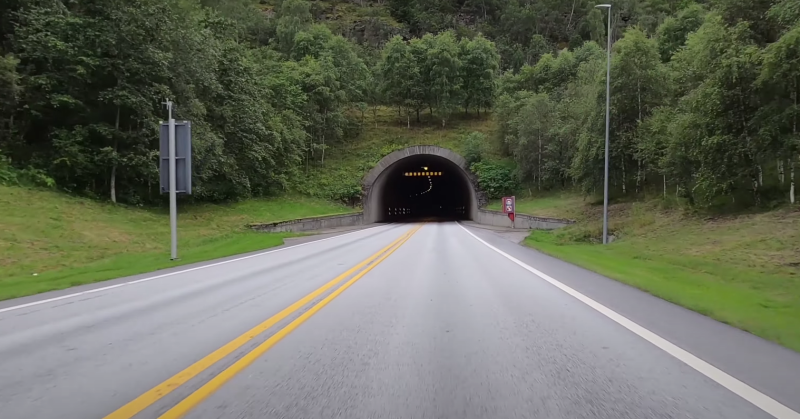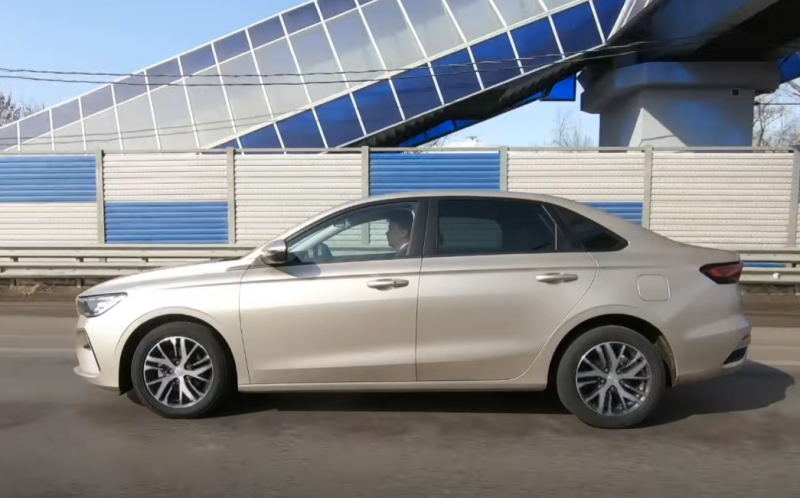Norway is famous for its heterogeneous landscape. The country's growing economy forces the authorities to constantly develop the road network. To overcome fjords, mountains, bays and rivers, it is necessary to develop and apply unique construction technologies.
But today we want to talk about the longest road tunnel, which was built in Norway in 2000. Its total length is 24,5 km and its diameter is 7,5 m. The Laerdal Tunnel connects the municipalities of Laerdal and Aurland in the western part of the country and is an important infrastructure facility for local residents and logistics companies. The highest point of the mountain where the path was dug is 1600 meters.
 Laerdal tunnel on the map. Photo: Yandex.ru/maps
Laerdal tunnel on the map. Photo: Yandex.ru/mapsTraffic is carried out in one lane in each direction; there are expansions only in parking areas and at U-turns.
Before the construction of the Lärdal tunnel, drivers had to make a detour of 240 kilometers, or cover this distance along an alternative mountain road. The old route was often closed during the winter months, and it was difficult to pass each other on the road. In fact, there is only one lane.
The tunnel was the completion of the European route E16, which allows you to travel between Oslo and Bergen without ferry service and difficult mountain crossings - serpentines.
The need for such a facility was discussed back in the 70s. In 1992, the Norwegians decided on a location and funding. Construction began in 1995. Over 5 years of work, 2,5 million cubic meters of rock were removed. The project cost was $113 million.
Interesting facts about the tunnel
Norwegians are famous for their quality and special approach to the construction of such facilities. It was clear to everyone that a long trip in a confined space can be tiring for drivers. The monotony of movement can lead to decreased concentration or falling asleep. To avoid this, three parking zones were built in the tunnel.
 Recreation areas in the Lärdal tunnel. Photo: YouTube.com
Recreation areas in the Lärdal tunnel. Photo: YouTube.comIn essence, these are large caves with special lighting, 500 m long. While the road itself is illuminated with warm-colored lamps, the parking lots are literally flooded with blue, cold light. This “resets” the brain, allowing drivers to relax and avoid claustrophobia. There are also rest areas and places for turning around. These parking lots are located at intervals of 6 km.
To further inform drivers, there are signs in the tunnel every kilometer indicating the distance traveled and the distance to the end of the underground part of the road. The central dividing strip has sound stripes - a special marking that causes the car to vibrate if at least one wheel runs into it. This is necessary in order to avoid unfocused attention of the driver and prevent deviation from the lane.
Security system in the tunnel
There are no emergency exits on this route. There is really no need for them, considering that there are hundreds of millions of tons of rock above the tunnel, and getting out of it along parallel pedestrian paths is quite problematic. Let me remind you that its length is more than 24 km. So in the event of a serious accident, “running to the exit” is unlikely to be possible.
But Norwegian engineers compensated for this deficiency by other means. For example, emergency telephones were installed every 250 meters. They can be used to contact the police, firefighters or hospitals. Fire extinguishers are located on the tunnel walls every 125 meters.
If the driver picks up an emergency phone or a fire extinguisher, the brake lights and warnings - “Turn around and get out” - are immediately activated. Along the entire length of the tunnel there are 15 turning areas, including parking areas. Drivers are required to drive to the nearest turn and proceed immediately to the exit. A warning will also light up at the entrance arches: “Tunnel is closed.” In addition, there are “safety pockets” every 500 meters where you can stop if your car breaks down.
 Laerdal tunnel. Photo: YouTube.com
Laerdal tunnel. Photo: YouTube.comThere are a large number of different cameras hanging in the tunnels. There is speed control. If drivers exceed the 80 km/h mark, they will have to pay a fine. There are no “thresholds” of 20 km/h in Norway. Exceeding up to 5 km/h – 6800 rubles, 6-10 km/h – 19000 rubles, etc. If you decide to drive 40 km/h faster than the limit, prepare to pay 90 thousand rubles.
Cars are also constantly counted at the entrances. That is, operators always know how many cars, equipment or buses are at the facility. Security centers operate 24 hours a day in Lerdan and Bergen to monitor traffic and emergencies. There is radio reception in the tunnel, mobile phones work, and it is possible to access the Internet.
Air quality
This is a very important component of the operation of any underground structure. The Norwegians took a responsible approach to the problem of maintaining the required amount of oxygen in the tunnel. Ventilation and air purification systems are working. Particulate matter (dust and soot) is removed by an electrostatic precipitator, and nitrogen dioxide is removed by a large carbon filter.
Powerful fans are installed at the entrances to draw in fresh air. In the center of the tunnel there is a ventilation shaft, which, on the contrary, works like an exhaust hood. In this way, it is possible to maintain a comfortable microclimate inside the building.
The Rogfast Tunnel is a Norwegian giant that can eclipse the glory of Laerdahl
By 2029, another underground highway is expected to open in Norway. Its length will be 27 km, and its maximum depth will be 392 meters. The tunnel will become part of the European highway E39 and will connect the cities of Kristiansand - Stavanger - Haugesund - Bergen. It is already known that drivers will be charged tolls. This is understandable; the cost of the project is estimated at at least €1,73 billion.
There is very little information on the features of this structure. We only know that after construction is completed, it will be the longest road tunnel in the world.
The future of Laerdahl
The Norwegian government is going to carry out a significant modernization of the tunnel. For this purpose, partial and complete closure of the track is planned for a certain period. Now they say that from 2025 the route will be closed for 14 hours every day for 4 years. Reconstruction is necessary to ensure that the tunnel meets updated traffic safety standards in the European Union. Most likely, the track lighting system and safety will be significantly improved.
 Departure from the Laerdal tunnel. Photo: YouTube.com
Departure from the Laerdal tunnel. Photo: YouTube.comNot all infrastructure facilities can boast of landmark status. But the Laerdal tunnel can. Every year, thousands of tourists plan their routes in such a way as to ride around this object and take some photos in the “ice caves”.
It seems that I also have a new item in the “must see” category. I hope there will be an opportunity to arrange a car tour of Norway and see with my own eyes all the beauties of this country.










